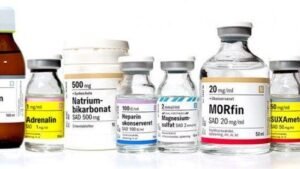The health and research lab labels industry is expected to be worth $9.2 billion in 2022, according to a survey published by FMI, Future Market Insights. Including a CAGR, the compound annual growth rate of 4.9 percent over the following eight years, this value is expected to climb to US$13.5 billion by 2030. The COVID-19 outbreak, demographic trends, and advances in medical technology are set to keep driving this expansion – while there may be hurdles ahead as pharmaceutical rules tighten and neighboring businesses grapple with supply chain issues.

Adjustment in COVID-19
The epidemic of COVID-19 has caused a profound shift in how customers engage with and connect to all items, including drugs. Increased awareness of disease transmission by touch with surfaces – particularly early in the pandemic, when this was proposed as a low-risk transmission pathway for SARS-CoV-2 – has fueled the urge for contactless alternatives across businesses.
The use of labeling to facilitate contactless healthcare, according to FMI, might have ramifications, allowing data to be informed among healthcare professionals, businesses, and patients while minimizing touch and the transmission of illness. This might indicate differences in the way physicians and pharmacists label pharmaceuticals and, as a result, administer them.
Customers tend to have grown more conscious of modern synchronization due to techniques like Barcode scanners that were used to ‘check in’ at events so that anybody infected with COVID-19 could be identified and detected. Furthermore, as COVID-19 rates of infection continue to climb, tracking, tracing, and recording data has grown more challenging, especially since the health care industry is under increasing strain due to personnel shortages. Digital labeling might assist in simplifying interconnections between patients and health care providers in the long term.

Furthermore, laboratory labels are required for purposes like countrywide COVID-19 testing programs. Considering investigations into infectious illnesses such as COVID-19 expected to grow, FMI emphasizes the need for laboratory labeling in ensuring the efficacy and safety of current and future studies.
“As a result of these reasons, the COVID-19 outbreak has catalyzed market growth, and desire for labeling will remain strong during the epidemiological period,” according to FMI.
The demographic factors influencing the growth
Medical labeling, as FMI says, is already a well-established and vital sector. Patients benefit from labels in various ways, such as learning how to use, securely store, and maintain medical equipment or drug. FMI adds that patients must be informed about the dangers and advantages of medical assistance so that they can comprehend, with labels playing a critical role in this communication. This sort of labeling can be supplied by the BOPET film manufacturer.
Developments in the medical sector and the approach to health care are delivered to be the primary factors of industry expansion. According to FMI, the usage of complicated medical equipment and treatments in the house is increasing, owing to competitive pharmaceutical firms’ r&d. Including newly updated technology. As a result, secure and reliable medical labeling will become even more crucial.

Significantly, the medical sector is conducting massive trials of novel equipment and pharmaceuticals in many sites worldwide. Organizations will need to guarantee they deliver relevant information during manufacturing, storage, shipping, and distribution, according to FMI, which will drive increasing needs for hospital and diagnostic labels. According to FMI, the tags will now have to be written in numerous languages to enable precise, localized communication, which will increase demand.
FMI also points out that prominent demographic trends are occurring, which are altering how individuals engage with their country’s or region’s healthcare system, with repercussions for labeling. With an aging population in many nations, utilization in medicine is expected to rise, pushing the growing market for healthcare labeling. You can check out the China BOPP film supplier for a cheap purchasing rate. Older persons were likely to utilize innovative packaging, including Qr code or NFC-enabled tags, if it was simple, reliable, and not too expensive.
Millennials, according to FMI, are a generation that places a premium on healthcare labeling. This demographic is said to be more prone to investigate items before making a purchase, and they prefer firms that are open about social and environmental impact. According to FMI, healthcare labeling will boost brand legitimacy to Millennial customers and provide expanded data transfers, such as a companion app for labeling solutions.

According to FMI, Youngsters are also engaged in health technology that encourages an active lifestyle, such as nutritional supplements. To capture this group and the development potential they provide, firms will presumably need to guarantee transparent and visible labeling.
Planning of the business and its components
FMI anticipates that sheet labels will continue to be the most popular regarding health label chemical compositions. Paper-based tags are said to be readily available and inexpensive, accounting for almost 65 percent of the clinical labeling market value.
According to FMI, polyolefin-based tags are estimated to offer a US$1.45 million additional potential during 2022 and 2030. This increment is seen due to the solid adhesive capabilities of polyolefin-based tags, which are vital for fast-growing categories like nutraceuticals.
FMI predicts that North America will continue to be the leading market for medical labeling in terms of geographical distribution. FMI credits the region’s emphasis on quality, such as tight FDA rules, to its health and pharmaceutical sectors, which contribute to over 30% of the market share for medicinal tags.
The second-largest marketplace for healthcare tags is East Asia. According to FMI, the area is “exhibiting significant development potential” due to increased healthcare expenditure, which might be attributed to the region’s expanding population and the attractiveness of “health tourism” in countries such as China, India, Malaysia, and Thailand. However, FMI predicts that the medical label sector in South Asia will grow at a similar rate, with a value CAGR of 7.5 percent.
FMI also sees Europe as a market with much room for growth in healthcare labeling. Within Europe, demand appears to be strongest in the United Kingdom, Belgium, Germany, Italy, Denmark, and France. Demand for sophisticated medicines and nutraceuticals is expected to fuel research and innovation in both goods and labeling opportunities in this area, according to FMI. The medical research sector in NAFTA nations is expected to grow, according to FMI.
“The medical and scientific labels market is fragmented,” FMI notes. “To obtain a competitive advantage, the market’s leading players are focused on extending their research globally, broadening their portfolio of products, and quick product advancement.”
Future challenges
The market for health and diagnostic labeling is not without its difficulties. Labeling firms must consider location-specific rules, which means labels may need to be modified depending on where the product is marketed, increasing operating costs and timelines.
According to FMI, the material composition, size, and imprinting of healthcare labels are all complicated by the unique environment of end-user needs. This appears to be a barrier for certain medical labeling firms since it can create unpredictable operational changes.
There are some new answers to these problems in the way. Schreiner MediPharm, for instance, lately announced the release of a Defrost cryogenic tag with an interlock multilayer approach that improves the adhesiveness of deep-frozen pharmaceutical containers. The firm sells tags that come with a booklet that can be extended or unrolled to reveal extra information, making these solutions ideal for clinical studies in many locations.
However, FINAT recently produced a study on the European label business, claiming that ingredient shortages, distribution network difficulties, and continuous strikes might hinder the growing market for label stock. Furthermore, Russia’s invasion of Ukraine might further destabilize the supply of commodities like timber and push up energy rates, putting a strain on energy-intensive businesses like paper and plastics, which are two of the most commonly used materials in healthcare labels. According to FINAT, this might imply that printers would soon be unable to fulfill orders, causing inefficiencies and label deficits in crucial sectors such as pharmaceutical labeling in the upcoming weeks.

